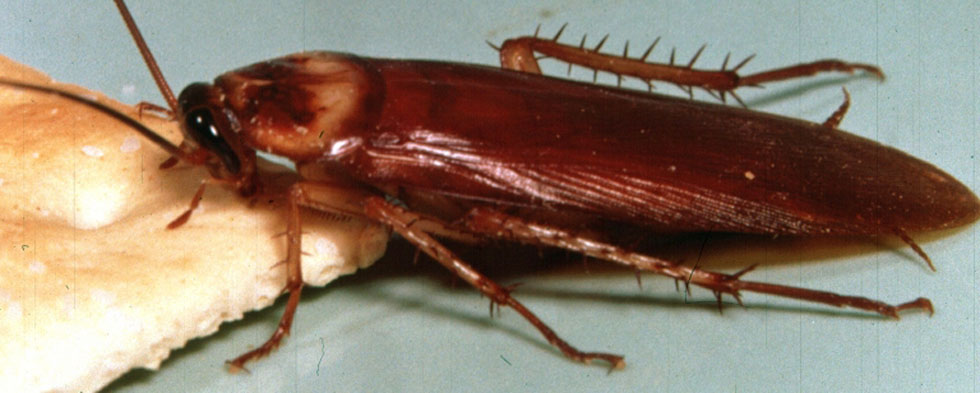Written by: Michael F. Potter and G. Mark Beavers
Cockroach Biology
Cockroaches are flattened, brownish, fast-moving insects, with long, slender antennae. They undergo gradual metamorphosis with three life stages: egg, nymph, and adult. Females produce small, brown, bean-shaped egg cases that are left in out-of-the-way places. Several immature cockroaches (nymphs) emerge from each egg case. The smaller, wingless nymphs live with or near adults and feed on the same items. They gradually become larger and develop wings.
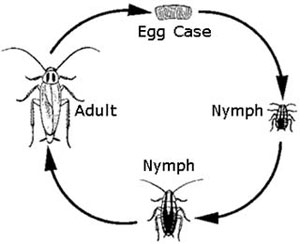
Life cycle of a cockroach: gradual metamorphosis (cockroach-pictures.com)
Cockroaches are among the most common insect pests found in buildings. Their presence is repulsive to most people. These insects are especially problematic where food is prepared and sanitation is poor. Cockroaches move freely from filth to food so they can transfer microorganisms that cause food poisoning and other illnesses. They may contaminate food, kitchen utensils, and other items, and leave an unpleasant musty odor. In addition, many people are allergic to cockroach excrement and their cast-off skins, resulting in wheezing, watery eyes, and skin rashes.
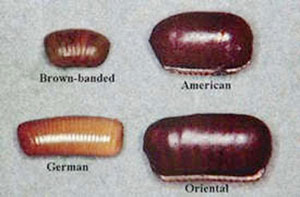
Eggs of common cockroach species (Univ Mn. Ext.)
Average eggs/case: Brown-banded (14), American (15) , German (60+) Oriental (18)
Cockroaches or their egg cases can be brought into buildings in produce boxes, beverage cartons, or grocery bags. American and Oriental cockroaches can crawl through cracks and openings around windows and doors, and through sewer and drain lines. While cockroaches thrive where sanitation is poor, even the cleanest home or restaurant can become infested. Cockroaches readily migrate from one room to another along plumbing and electrical lines and through cracks and openings within walls.
Cockroaches are most active at night. They hide during the day in cracks, crevices, and other dark, secluded areas which provide warmth and humidity. They leave their hiding places at night in search of food. Cockroaches will eat most anything, including food scraps, glue, hair, soap, fabrics, and filth.
Common Pest Species
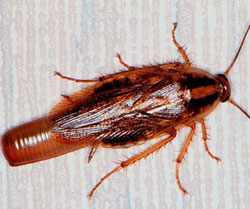
Female German cockroach carrying egg case.
Note 2 dark bars behind the head (www.pestrx.com)
German Cockroach
The German cockroach is the most common and important public health species. Adults (about 1/2 inch long) are light brown with two parallel dark bars on the shield-like area behind the head. The nymphs are smaller and darker with a tan stripe down the middle of the back. German cockroaches have the shortest life cycle of the pest species, which allows them reproduce very rapidly. This makes control difficult. A single mated female can produce an infestation of several thousand new roaches in less than a year.
German cockroaches require warmth, moisture, and food so they are most common in kitchens, bathrooms, and eating areas. They prefer hiding in cracks and crevices under sinks and toilets; beneath refrigerators, ice machines, dishwashers, and stoves; next to trash containers; and inside cabinets and pantries. These cockroaches also congregate in clocks, microwave ovens, and other electronic equipment. When populations are large or food is scarce, they can be found in bedrooms, closets and other non-food areas. German cockroaches spend most of their time hidden in cracks and crevices, but can be quite mobile. They often travel between rooms or adjoining apartments along utility pipes and wires, and within wall voids.
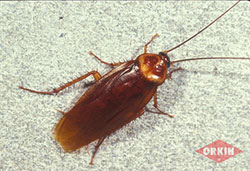 American cockroach
American cockroach
American Cockroach
The American cockroach is the largest species (1-1/2 inches long) found in Kentucky. This reddish-brown to brown insect has a pale yellow band around the edge of the shield behind the head. Adults have well-developed wings but seldom fly. Nymphs are smaller and wingless. The developmental rate of the American cockroach is much slower than the German cockroach, usually requiring more than a year to develop from egg to adult.
American cockroaches prefer dark, moist areas, such as in basements and crawl spaces. They are often found in floor drains, sump pumps, pipe chases, and laundry areas. Other preferred sites are boiler rooms, steam heat tunnels, and sewers. During warmer months, this cockroach may be found outdoors and around outbuildings and woodpiles.
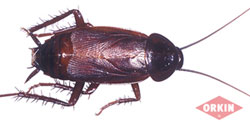
Male Oriental cockroach with
wings that cover about half of the back.
Oriental Cockroach
The Oriental cockroach is shiny black or dark brown, adults are about 1 inch long. Females have very short wings while males have wings that cover about half the abdomen. Development from egg to adult may require one to two years. it is one of the filthiest cockroach species because it commonly infests cool, dark, damp places (e.g., sewers and basements) where it feeds on garbage, human waste, and decaying organic matter. The nymphs and adults are comparatively slow-moving and are generally found at ground level. They often live in floor drains and sump pumps. During warmer months, Oriental cockroaches can live outdoors beneath leaves and plant mulch.
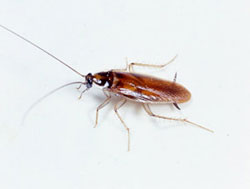
Brown banded cockroach (stopbuggingmenow.com)
Brown Banded Cockroach
The brown-banded cockroach is much less common than the German cockroach but can be an occasional problem. Correct identification is important because it has different hiding places and habits than the German cockroach. The brown-banded cockroach is similar in size to the German but does not have the dark lengthwise stripes on the region behind the head. Instead, there are two transverse yellow bands across the base of the wings. The brown-banded cockroach does not stay near water like the German cockroach, it can be found anywhere in a building. This species is more often found in homes and apartments than in restaurants and other commercial food-handling establishments. Preferred locations include upper areas of ceilings, walls, cabinets, and closets; behind picture frames and wall decorations; and beneath or inside furniture. It attaches its pea-sized egg capsules to hidden surfaces, such as the undersides of dressers and tables.
Cockroach Management
Cockroaches may hide in many places so a thorough inspection is essential to locate as many of these sites as possible. During inspections, consider the unique habits and preferred harborage sites of the different species. A bright flashlight, inspection mirror (for inspecting underneath, above and behind construction elements), and a set of screwdrivers, pliers, etc., to access equipment and other potential hiding places, are essential tools for conducting a professional cockroach inspection.
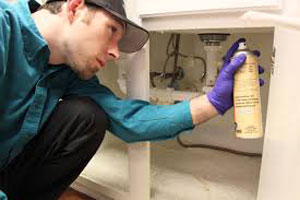
Using pyrethrins aerosol to flush cockroaches during an inspection (paramountexterminating.com)
The use of a flushing agent (natural pyrethrins) can also help to reveal hidden pockets of cockroaches. Pyrethrins are highly irritating to cockroaches and force them into the open. Sticky traps and glue boards are useful tools for pinpointing areas where cockroaches may be hiding. Placed monitoring traps at strategic locations, such as beneath sinks or behind refrigerators, and positioned flush against walls, corners, or at the junction of two or more construction elements. When foraging for food, cockroaches prefer to travel along edges and corners where two surfaces meet, rather than in the open.
Cockroach inspections must be organized and methodical. Otherwise, areas harboring cockroaches may be missed. This is especially true when in restaurants and other commercial food handling establishments where there are countless cracks and crevices. Begin at a door or corner and inspect one 3- to 5-foot "zone" (extending from floor to ceiling) at a time. Continue around the perimeter of each room (kitchen, dining area, etc.), inspecting sinks, ovens, dishwashers, cabinets, and any wall-mounted fixtures or equipment. Make periodic "sidetrips" toward inner portions of rooms, i.e., away from wall areas, to inspect equipment, tables, etc.

Food, moisture, and shelter for cockroaches (sparkspace.com)
Successful cockroach control requires a combination of techniques. Cockroaches flourish where food, moisture, and shelter are readily available so sanitation is an important step in preventing problems. Crumbs, spills, grease, and other food debris should be cleaned. Unwashed dishes, kitchen utensils, and food should not be allowed to set overnight. Loose food should be stored in tight-fitting containers, and garbage, cardboard boxes. Paper bags should not be allowed to accumulate. Items in food storage areas should be removed from cardboard boxes and stored off the floor on stainless steel racks. Moisture leaks should be repaired and floor drains routinely sanitized.
Another element of cockroach management is exclusion or pest-proofing. This involves the use of sealants such as caulk, foam, copper mesh, or cement. Sealing cracks, crevices, and other openings likely to harbor cockroaches eliminates the need to repeatedly treat these areas with insecticides. It is also a good idea to caulk or plug any openings where plumbing pipes or wires pass through walls or floors. This is especially useful in apartments to reduce migration of cockroaches between adjoining units.
Although good sanitation and exclusion are important, insecticides are usually required to eliminate a serious existing cockroach problem. Safe, effective treatments depend the type of insecticides used and how they are applied. Cockroaches spend very little time out in the open. Focus on finding and treating cockroach harborages rather than exposed surfaces. Besides being more effective, directed placement of insecticides into cracks, wall voids, and other hidden locations ensures that residues will not contaminate food or food preparation surfaces, or be contacted by children or pets.
Insecticides
A variety of insecticide active ingredients and formulations is available for cockroach control.
Residual insecticides are commonly used. They provide effective control that lasts from a few days to several months. Cockroaches are killed by residual treatments if they remain on a treated surface long enough to absorb a lethal dose of insecticide. Residual insecticides may be formulated and applied as liquid or aerosol sprays, dusts, granules, or baits. Liquids and aerosols are typically injected into cracks and crevices, while dust formulations are used primarily for treating wall voids and hollow spaces beneath cabinets and appliances.
Baits are also used widely in cockroach control and contain such active ingredients as hydramethylnon, sulfluramid, boric acid, and abamectin. Cockroach baits contain a slow-acting insecticides incorporated into a food attractant. The insects find and feed on the bait and crawl away to die, usually within a few days. Bait carried back to the nesting area also kills other cockroaches after being expelled in the sputum and feces. Some baits come pre-packaged with the insecticide and food attractant within a plastic, child-resistant container. Others are formulated as pastes, dusts, granules, or gels. Since baits must be ingested to be effective, they must be placed within a few feet of where cockroaches are likely to be living.
Non-residual insecticides are those products applied to obtain control of cockroaches only during the time of treatment. Pyrethrin or resmethrin are often used in conjunction with residual products to locate and "flush out" hidden infestations of cockroaches. They can also provide rapid (although short-lived) knockdown of cockroaches present at the time of application. Non-residual insecticides are usually applied with aerosol or ultra low volume (ULV) equipment, and directed into areas suspected of harboring cockroaches. Indiscriminant dispersal of non-residual insecticides into the air (i.e., fogging or space treatment) in kitchens, dining rooms, storage areas, etc., should be avoided because it will only disperse and drive cockroaches deeper into wall voids and other protected locations.
Because cockroaches are typically found in areas where food is prepared or stored, special care must be taken not to contaminate food, dishes, cooking utensils, or food preparation surfaces. Before treatment, these items should be removed, placed in plastic bags, or covered with polyethylene sheeting. Before treatment, it is essential that all insecticide labels be read in their entirety. Some products can only be used in "non-food" areas such as garbage rooms and mop closets, where foods are never processed, prepared, served, or stored. Other insecticides can only be applied into cracks and crevices to limit potential contact with food or food preparation surfaces. As with any insecticide application, the label is the best guide.
[return]
